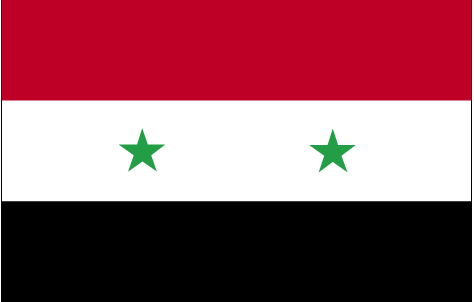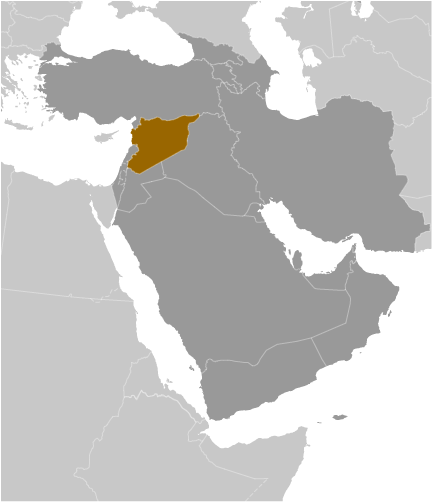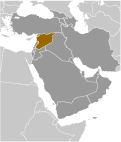
|
|
Advertisements:
EconomyEconomy - overview
After modest economic reform in recent years, Syria's economy suffered the effects of political unrest and violence in 2011. Economic growth slowed because of international sanctions and reduced domestic consumption and production. Prior to the unrest, Damascus had cut lending interest rates, opened private banks, consolidated multiple exchange rates, raised prices on some subsidized items, and established the Damascus Stock Exchange, which began operations in 2009. The economy remains highly regulated by the government, which has increased subsidies and tightened trade controls to assuage protesters and protect foreign currency reserves. Long-run economic constraints include foreign trade barriers, declining oil production, high unemployment, rising budget deficits, and increasing pressure on water supplies caused by heavy use in agriculture, rapid population growth, industrial expansion, and water pollution. Gdp (purchasing power parity) World Ranking: 69
$107.6 billion (2011 est.)
$111.5 billion (2010 est.) $107.8 billion (2009 est.) Note Data are in 2011 US dollars Gdp (official exchange rate)
$64.7 billion (2011 est.)
Gdp - real growth rate World Ranking: 209
-2% (2011 est.)
3.4% (2010 est.) 5.9% (2009 est.) Gdp - per capita (ppp) World Ranking: 151
$5,100 (2011 est.)
$5,200 (2010 est.) $5,100 (2009 est.) Note Data are in 2011 US dollars Gdp - composition by sector
Agriculture 16.9%
Industry 27.4% Services 55.7% (2011 est.) Labor force World Ranking: 68
5.642 million (2011 est.)
Labor force - by occupation
Agriculture 17%
Industry 16% Services 67% (2008 est.) Unemployment rate World Ranking: 130
12.3% (2011 est.)
8.6% (2010 est.) Population below poverty line
11.9% (2006 est.)
Household income or consumption by percentage share
Lowest 10% NA%
Highest 10% NA% Investment (gross fixed) World Ranking: 72
21.6% of GDP (2011 est.)
Budget
Revenues $11.69 billion
Expenditures $17.87 billion (2011 est.) Taxes and other revenues World Ranking: 181
18.1% of GDP (2011 est.)
Budget surplus (+) or deficit (-) World Ranking: 193
-9.5% of GDP (2011 est.)
Public debt World Ranking: 98
35.2% of GDP (2011 est.)
22.6% of GDP (2010 est.) Inflation rate (consumer prices) World Ranking: 118
4.8% (2011 est.)
4.4% (2010 est.) Central bank discount rate World Ranking: 69
0.75% (31 December 2011 est.)
5% (31 December 2010 est.) Commercial bank prime lending rate World Ranking: 96
10.5% (31 December 2011 est.)
10% (31 December 2010 est.) Stock of narrow money World Ranking: 64
$22.37 billion (31 December 2011 est.) $22.78 billion (31 December 2010 est.) Stock of broad money World Ranking: 69
$46.52 billion (31 December 2011 est.) $161 billion (31 December 2009) Stock of domestic credit World Ranking: 70
$31.84 billion (31 December 2011 est.) $27.68 billion (31 December 2010 est.) Market value of publicly traded shares
$NA
Agriculture - products
Wheat, barley, cotton, lentils, chickpeas, olives, sugar beets; beef, mutton, eggs, poultry, milk Industries
Petroleum, textiles, food processing, beverages, tobacco, phosphate rock mining, cement, oil seeds crushing, car assembly Industrial production growth rate World Ranking: 53
6% (2010 est.)
Electricity - production World Ranking: 57
38.71 billion kWh (2008 est.)
Electricity - consumption World Ranking: 61
28.99 billion kWh (2008 est.)
Electricity - exports
0 kWh (2009 est.)
Electricity - imports
0 kWh (2009 est.)
Oil - production World Ranking: 34
401,000 bbl/day (2010 est.)
Oil - consumption World Ranking: 45
292,000 bbl/day (2010 est.)
Oil - exports World Ranking: 44
263,000 bbl/day (2009 est.)
Oil - imports World Ranking: 83
55,280 bbl/day (2009 est.)
Oil - proved reserves World Ranking: 33
2.5 billion bbl (1 January 2011 est.) Natural gas - production World Ranking: 48
6.19 billion cu m (2009 est.)
Natural gas - consumption World Ranking: 53
7.1 billion cu m (2009 est.)
Natural gas - exports World Ranking: 189
0 cu m (2009 est.)
Natural gas - imports World Ranking: 60
910 million cu m (2009 est.)
Natural gas - proved reserves World Ranking: 43
240.7 billion cu m (1 January 2011 est.) Current account balance World Ranking: 171
-$7.15 billion (2011 est.)
-$367 million (2010 est.) Exports World Ranking: 102
$8.112 billion (2011 est.)
$12.27 billion (2010 est.) Exports - commodities
Crude oil, minerals, petroleum products, fruits and vegetables, cotton fiber, textiles, clothing, meat and live animals, wheat Exports - partners
Iraq 38.8%, Italy 7.9%, Germany 7.1%, Saudi Arabia 6.5%, Kuwait 4.2% (2011) Imports World Ranking: 88
$12.93 billion (2011 est.)
$15.94 billion (2010 est.) Imports - commodities
Machinery and transport equipment, electric power machinery, food and livestock, metal and metal products, chemicals and chemical products, plastics, yarn, paper Imports - partners
Saudi Arabia 14.5%, China 10.1%, UAE 7.1%, Turkey 6.7%, Iran 5.3%, Italy 5%, Russia 4.5%, Iraq 4.3% (2011) Reserves of foreign exchange and gold World Ranking: 67
$14.83 billion (31 December 2011 est.) $19.52 billion (31 December 2010 est.) Debt - external World Ranking: 104
$7.074 billion (31 December 2011 est.) $7.295 billion (31 December 2010 est.) Exchange rates
Syrian pounds (SYP) per US dollar - 11.225 (2011 est.)11.225 (2010 est.) 46.708 (2009) 46.5281 (2008) 50.0085 (2007) Fiscal year
Calendar year
Comments
Add a new comment: |
Advertisement
Members area
Syria (Damascus):
 
GPS points from Syria (Damascus)
|
||||||||

 Following World War I, France acquired a mandate over the northern portion of the former Ottoman Empire province of Syria. The French administered the area as Syria until granting it independence in 1946. The new country lacked political stability, however, and experienced a series of military coups during its first decades. Syria united with Egypt in February 1958 to form the United Arab Republic. In September 1961, the two entities separated, and the Syrian Arab Republic was reestablished. In November 1970, Hafiz al-ASAD, a member of the Socialist Ba'th Party and the minority Alawi sect, seized power in a bloodless coup and brought political stability to the country. In the 1967 Arab-Israeli War, Syria lost the Golan Heights to Israel. During the 1990s, Syria and Israel held occasional peace talks over its return. Following the death of President al-ASAD, his son, Bashar al-ASAD, was approved as president by popular referendum in July 2000. Syrian troops - stationed in Lebanon since 1976 in an ostensible peacekeeping role - were withdrawn in April 2005. During the July-August 2006 conflict between Israel and Hizballah, Syria placed its military forces on alert but did not intervene directly on behalf of its ally Hizballah. In May 2007 Bashar al-ASAD was elected to his second term as president.
Following World War I, France acquired a mandate over the northern portion of the former Ottoman Empire province of Syria. The French administered the area as Syria until granting it independence in 1946. The new country lacked political stability, however, and experienced a series of military coups during its first decades. Syria united with Egypt in February 1958 to form the United Arab Republic. In September 1961, the two entities separated, and the Syrian Arab Republic was reestablished. In November 1970, Hafiz al-ASAD, a member of the Socialist Ba'th Party and the minority Alawi sect, seized power in a bloodless coup and brought political stability to the country. In the 1967 Arab-Israeli War, Syria lost the Golan Heights to Israel. During the 1990s, Syria and Israel held occasional peace talks over its return. Following the death of President al-ASAD, his son, Bashar al-ASAD, was approved as president by popular referendum in July 2000. Syrian troops - stationed in Lebanon since 1976 in an ostensible peacekeeping role - were withdrawn in April 2005. During the July-August 2006 conflict between Israel and Hizballah, Syria placed its military forces on alert but did not intervene directly on behalf of its ally Hizballah. In May 2007 Bashar al-ASAD was elected to his second term as president.